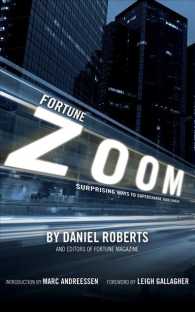- ホーム
- > 洋書
- > 英文書
- > Literary Criticism
Full Description
Why are contemporary crime dramas so often filmed in lush settings? From the supernatural woodland of Twin Peaks and The Blair Witch Project, to the haunting bayous of True Detective, landscape takes a starring role. Lakes are particularly dangerous and recur time and again in crime drama, most recently in New Zealand's Top of the Lake, Karen Fossum's Girl by the Lake, French film Stranger by the Lake, and British crime film Eden Lake.
This volume asks what it is that draws our narrative imaginations so compellingly towards crime dramas that take place in unspoilt, sublime locations. Beginning with Ovid's most striking poetic special effect, the locus terribilis, which uses stunning, natural locations as the setting for violence, the book traces his influence and asks what this particular contrast has to tell us about our relationship to our landscapes, our bloody colonial histories, and our current ecological fears. Laura Joyce offers a fresh perspective on contemporary crime television and cinema using the lens of classical, and specifically Ovidian, reception.
Contents
Introduction: Twin Peaks, 1991-2017, Classical Reception and Contemporary Rural Horror
1. From Locus Amoenus to Locus Terribilis
2. Central Europe's Gloomy Forests and Sinister Lakes
Stranger by the Lake and the Myth of Salamcis
Eden Lake, Kill List, and the Myth of Tereus and Philomela
The Locus Post-Terribilis: Southcliffe, In the Fog, A Field in England, and Archipelago
3. (Un) Settling in North America
It Comes at Night and Cephalus and Procris
The Blair Witch Project, Butter on the Latch and the Myth of Narcissus
The Locus Post-Terribilis: Thou was Mild and Lovely, True Detective, and Foxcatcher
4. The Australian Wilderness
Jindabyne and the Myth of Daphne and Apollo
Top of the Lake and the Myth of Diana and Actaeon
The Locus Post-Terribilis: Snowtown, The Kettering Incident, and Picnic at Hanging Rock
5. The Locus Hospitalitas
Filmography
Bibliography
Index







